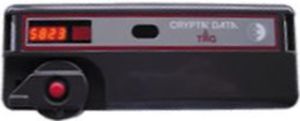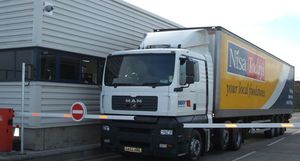Nisa-Today’s , the United Kingdom’s largest grocery buying and distribution consortium of independent retailers and wholesalers, is operating an RFID-based system to increase security for loaded trailers while they wait for pickup in the yard and while they are in transit.
The security system is based on reusable RFID electronic seals that are placed on each trailer. The seals, supplied by Unisto Electronic Seals (formerly Encrypta), generate four-digit random numbers every time they are closed and record the time and date of each opening and closing in the seal’s memory.
This allows operators to verify that the load has not been tampered with by checking to make sure the original seal number recorded after the loading of the trailer at Nisa-Today’s distribution center, operated by Re-vision Logistics, on behalf of Bibby Distribution, has remained unchanged while the trailer has been stored in the yard or while a driver is on the road.
Each seal’s ID and closing serial numbers are collected automatically when an active RFID tags, Crypta Data Tag, embedded in the seal is read by one of the interrogators positioned around the trailer yard and at the gatehouse at the entrance to the yard.
The system helps expedite deliveries of 1.2 million cases of goods each week because the opening and closing times of the seals can be compared with each day’s routing schedule to find out about potential delivery delays. If the system indicates that a trailer has not been delivered and opened at the expected time, operators of the system can contact the driver to find out why there has been a delay.
Theft of high-value but small items such as cigarettes or alcohol continues to be a problem at busy distribution centers, and the e-seals are helping to reduce it. Re-vision Logistics wanted to detect if people were stealing from the trailers in the parked in the yard.
“If a trailer is opened in the yard, then its ID and the fact that it has been opened comes up at the gatehouse,” says Mark Hayward, sales and marketing director of Unisto.
Nisa-Today’s recently built a new 625,000-square-foot distribution center in the Foxhills Industrial Park in Scunthorpe in the United Kingdom and renewed its partnership with Bibby, which manages the contract for Nisa-Today’s DC. To improve onsite security at the new DC, which opened in October of last year, Bibby purchased and implemented a trailer seal application for 150 trailers. The onsite security application, called YardTrak, is an extension of Unisto’s GateSuite system Bibby was already using to track and manage trailers leaving the yard (see Encrypta’s GateSuite Provides On-Site Security). Bibby spent around 175,000 British pounds on the system.
GateSuite is a set of modular Windows-based software programs that run on Microsoft.Net and communicate with warehouse management systems or route scheduling systems. The whole software package can be used to prepare delivery routes and schedules, allocate trailers and drivers, control who comes in and out of the yard and manage the yard.
In the first step of the process, Re-vision Logistics personnel in transport planning use GateSuite to determine a route for goods that need to be delivered and assign those goods to an empty trailer in the yard.

This information is entered into the computer, and the trailers are brought to the loading dock. After loading, the Crypta electronic seal on the trailer is closed. When it is closed, the seal’s four-digit code is noted by hand on the load’s manifest and later entered manually into the system. Hayward expects that during the first quarter of 2007, Bibby will start using a handheld RFID interrogator to read the seal number and enter it into the system, allowing for full automated manifest information. This was not initially implemented because Bibby’s route management and warehouse management software didn’t allow for it.
The tag inside the seal wakes up when it receives a 134.2 kHz signal from the interrogator and transmits at 433 MHz. Powered by a battery with an expected life of five years, the tag has a read range of up to 100 meters (328 feet). Seals have been tested independently to BS2011 standards and are designed to keep out water, salt and dust.
After the trailer is loaded, the seal is closed and the seal number has been recorded, the trailer is moved to the yard, where an RFID interrogator reads the number and updates the system about which zone the trailer is parked in. Operators then know that the trailer is ready and waiting in a particular zone and can be hitched up to a truck for delivery to a store or multiple stores. If the seal is broken while the loaded trailer is waiting to be picked up, the tag will transmit the new seal number to an interrogator, thereby alerting the system’s operators that the trailer is being opened.
In addition to the Crypta seal on loaded trailers, all trailers in the yard and all trucks pulling these trailers carry 134.2 kHz passive tags made by Texas Instruments as part of the initial application that helps Bibby determine that trucks and trailers are properly matched.
The initial system was implemented because Bibby wanted to stop drivers from coming on site and stealing loaded trailers. All drivers are photographed and registered, and information on drivers who no longer work for the company is deleted immediately.
After a driver receives his assignment, he hitches up his truck to the loaded trailer and drives to the security gate at the yard’s entrance and exit. The gate is outfitted with a Texas Instruments interrogator with about 4 square meters worth of loops buried in the ground. The loops constantly emit signals to read the passive tags on the trucks and trailers moving about 15 to 20 miles an hour, confirming that tractors and trailers are properly matched.
The interrogator for the active electronic seals is mounted at the gate, and this reading is taken as well. This interrogator can also transmit data back to the e-seals to update information such as electronic manifests (if a customer wants this). The seal has 32 KB of memory.
After both interrogators have performed their appropriate readings, the system is updated. The computer matches all corresponding information, and the guard at the gate sees both the route plan and a picture of the driver on his screen. If the truck, trailer, driver or seal number is wrong or mismatched, the guard will be alerted. If all information is correct, the guard visually identifies the driver. The barrier goes up, and the driver is allowed to pass.
The whole ID process takes only several seconds, keeping traffic from stalling at the gate and cutting down on wasted fuel.

When the driver arrives at his first destination, workers unloading the truck can look at the four-digit number noted on the manifest and compare it with the number on the tag. If there’s a match, the retailer then knows he is receiving an unopened shipment of goods.
If a driver makes a single delivery, the time of opening of the seal will be stored in the seal’s memory, and the driver notes the new four-digit number by hand on the load manifest.
If a driver is making multiple deliveries on a run, he will reseal the load after each drop and write down the new numbers that appear in the lighted display each time the seal is closed. When the empty truck and trailer return to the yard, the interrogator at the gatehouse reads the latest e-seal number. The yard management system verifies the number of drops by examining the number of times the seal was closed and comparing these with the route plan. If three drops were planned and three closures were noted, the barrier raises and a driver can pass. If the number of drops and planned drops do not jibe, the guard then questions the driver.
“This is all about controlling the driver and making sure that he doesn’t stop en route and take something out,” says Hayward. “It’s all about securing the load.”
Jeremy Blakey, Re-Vision Logistics’ director, has been working on the project since its beginning. He says drivers like the system because it can be used to independently verify their honesty.
“We have had a couple of incidents, and the Crypta seal data enabled us to completely rule out the drivers as having any possible involvement,” he said, adding: “You can never stop a determined thief, but you can make it very hard for them to succeed. The level of security that this Unisto system provides is a powerful deterrent. Word has spread via drivers, suppliers, etc., that we would not be an easy target.”
When the system was implemented, Unisto faced problems interrogating the e-seals because they are bolted to roller shutter doors that are then blocked by trucks’ steel tail lifts. This made it difficult to wake up the seal at a low frequency. Unisto solved the problem by repositioning the antenna at a lower level.
“Our problems were mainly about the antenna and the positioning of the antenna,” Hayward says. “It took a lot of development work on the antenna to get it to point in the right direction.”


